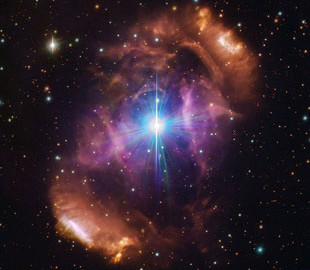
According to new data obtained during the study of a binary system shrouded in a dusty and element-rich nebula, massive stars acquire their magnetic fields as a result collisions and mergers with other stars.
In the thick of this nebula, known under the dual designation NGC 6164/6165, is the star system HD 148937. Located about 3,800 light-years away in the southern hemisphere constellation Norma, this system contains two massive stars orbiting general center. One of these stars, the brightest and hottest of them all, has a magnetic field. This arouses the interest of scientists, because according to current ideas about the internal structure of stars, massive stars should not have magnetic fields.
We usually think of the Sun as a typical magnetic star with phenomena such as sunspots, flares, and the solar wind. The Sun's magnetic field is generated at the boundary between the inner radiation layer and the outer convection layer. In the radiative layer, energy is transferred from the core by sources of gamma radiation, and in the convective layer, this energy is transformed into a flow of hot plasma, which rises to the visible surface of the Sun, where the energy is released as light and heat.
However, with as the mass of the star increases, the convective layers decrease, which makes the generation of magnetic fields more difficult. Red dwarfs are almost entirely convective and magnetically active. However, the more massive the star, the smaller the convective layer. This means that the most powerful stars without a convective layer cannot generate a magnetic field.
Nevertheless, observations show that about 7% of the most powerful stars still have magnetic fields, which is a mystery to astronomers. The clue to this phenomenon likely lies in the star HD 148937.
A team of researchers led by Frost and Hugo Sahn of the University of Leuven in Belgium conducted an extensive study of HD 148937 using nine years of interferometer data of the ESO telescope in Chile.
Their analysis found that the more massive of the two stars appears to be significantly younger than its companion, which is contrary to expectations since both stars should have formed at the same time. The mass of the larger of the two stars is 50-60 solar masses, and it has a magnetic field. At the same time, it appears to be 1.5 million years younger than its companion, a significant difference for massive stars, which typically live only a few million years before going supernova.
In addition, scientists have drawn attention to the nebula surrounding the system HD 148937. Its shape indicates that it arose as a result of the outburst of one of the stars of this system only 7,500 years ago. The nebula contains high concentrations of carbon, nitrogen and oxygen — elements that are normally found inside stars but not outside.
Frost and Sana's observations were able to piece together this stellar puzzle of the system HD 148937. That one of the stars in this binary system appears to be younger than its companion, which suggests a possible merger that has occurred in this system in the last few thousand years.
"We assume that there were at least three stars in this system originally. “Two of them were close to each other, while the third star was much further away,” the scientists said.
According to this theory, HD 148937 was once a compact binary system around which a third star was located. Two neighboring stars merged into one star, ejecting excess material along their new axis of rotation, resulting in the formation of a nebula. Inside only the new star, changes are still taking place: the stellar material of the two stars is mixed, giving the new star a younger appearance, and the turbulent and convective environment in its interior is capable of generating a magnetic field with an intensity of 1 kilogauss (the Sun's magnetic field is 1 Gauss on average).
The magnetic field will not last long – the inner regions of the star will eventually mix completely, after which the magnetic field will “turn off”. This not only indicates that stellar mergers must have occurred relatively recently, but also projects the 7% of massive stars with magnetic fields into the context of merger rates in close binary systems.
